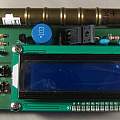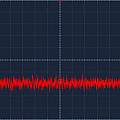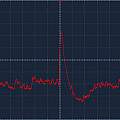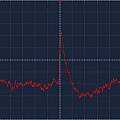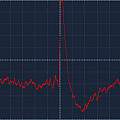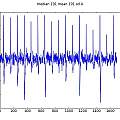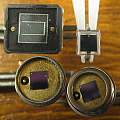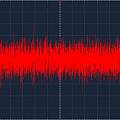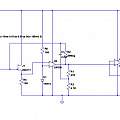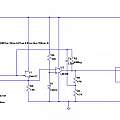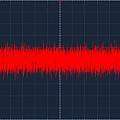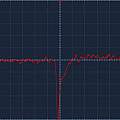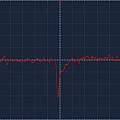Started 16th May 2018
I wanted a particular Minolta camera lens for a project, the internet pointed out "some of these lenses were made of radioactive glass and no way should you be holding such a thing to your eye". I ended up buying a Geiger counter from Japan; it showed no radiation from the lens.
"Ah but the glass may be pouring out radiation at too low an energy to trigger your toy counter." Maybe so; but the lens fell foul of the rule that as soon as one gets something the need for it vanishes; beautiful piece of glass, painstakingly hunted on ebay, used once.
Radioactivity has a high "yuk" factor, having the detector is bad enough, people don't want to know what the background count is today, or that matter is disintegrating.
I tried to find some radioactivity. Bananas worked as did "Lo Salt" (sodium replacement salt) (you're going to eat this?) and sulphate of potash - plant food. They all contain potassium, results are a bit tame, count for a minute or two and there is an effect, but it's not like in the movies "the Geiger counter is going crazy!"
As a lad I went on holidays in a caravan with gas lights. When the mantles burned out and were discarded I'd play with them (it rained a lot). I found an unused one recently and it triggered the counter noticeably, even without opening the cardboard box. Here the active ingredient is thorium.
The ideal then is an immediate and noticeable effect - from low levels of radiation. It is no fun to have to process huge amounts of data over long times to detect something or to be exposed to harmful levels of radiation.
I bought my Geiger counter from Japan because that was the place that had most recently had a nuclear disaster (Fukushima) and the GM tubes available at low cost come from the former USSR and allies. It was simpler to have someone else sort out getting the pieces.
I became aware that silicon photodiodes can be used to detect radiation from Alan Yates's blog [1]. This seems like fun, low cost, less easy to damage and freely available. There are a number of articles which appeared around the same time which use this idea.
I ended up building the Elektor circuit [3] but with the JFET used by Alan Yates. The Elektor circuit uses a JFET source follower to buffer the photodiode and then two LM358 operational amplifier stages, each with a gain of 33, giving an overall gain of around 1000.
The graphic below shows the basic circuit. LT Spice file
The Elektor and Alan Yates designs represent one approach, they use the photodiode to produce a current through a high value resistor and amplify the resulting voltage. Another way is to use a transimpedance amplifier (a current to voltage converter) [2].
Reading Horowitz and Hill The Art of Electronics third edition, it is apparent that detecting small currents from photodiodes is a problem that a lot of effort has been put into by many people.
From Wikipedia "Potassium-40 makes up 0.012% of the total amount of potassium found in nature. It undergoes both types of beta decay. About 89.28% of the time, it decays to calcium-40 (40Ca) with emission of a beta particle with a maximum energy of 1.31 MeV and an antineutrino. About 10.72% of the time it decays to argon-40 (40Ar) by electron capture, with the emission of a 1.460 MeV gamma ray and a neutrino."
I used as a test sample 68 gm of sulphate of potash. Potash is something one chucks about in the garden, breathes in and eats stuff grown in. The GC10 GM tube counter has a background value of 16 counts per minute and for this sample gives 86 counts per minute,
Sulphate of potash (potassium Sulphate) contains 42% potassium. The molar mass of potassium is 39 gm/mol
So my 68 gm contains ` 68/39 * N_A * 0.42 * 0.00012 = 5 × 10^19` atoms of potassium 40, where `N_A` is Avogadro's constant `6 × 10^23`
Activity, A (decays/sec) is given by:
`A=N * ln2 /tau`
Where the half life `tau = 1.251×10^9` years or `3.945×10^16` seconds and `N` is the number of atoms.
giving about 1500 decays per second, or around 150 gamma decays per second. (see Wikipedia - Banana equivalent dose for similar calculations).
I connected a BPW34 pin photodiode to my version of the Elektor circuit. Interference is a problem and I put the circuit along with battery power supply in a metal tin fitted with a BNC socket and used a coaxial connection to my 'scope. Despite this screening, external signals are picked up, the 50 Hz from the LED (fluorescent replacement) lights in my office is very visible.
The first 'scope picture shows noise is around 20 mV. The remainder show that one can get pulses of around 80 mV from decays.
Given the screening is not perfect, how do I know these pulses come from decays and not from freezer thermostats - by comparing results with and without the potash sample in the metal tin with the circuit. At first I added an "active buzzer" to give a click sound for each pulse detected. But the rate of events is too low for this to be useful.
I ended up connecting an Arduino Pro Mini (ATMega 328p) as an analogue to digital converter, this runs at 9600 samples per second and produces a single byte representing 0...255 mV via a serial port set to 115200 bits per second. A Python program copies the data to a file. Another Python program analyses the data files and draws graphs. From this the rate of events is about two per minute.
Download
- Rad01 Arduino sketch for analogue to digital converter (15th June 2018)
- logdata03.py copy serial port data to file (15th June 2018)
- Plot01.py analyse data (15th June 2018)
The plot program looks for signal levels significantly greater than the average (eight standard deviations) and then copies a number (50 before and after) of surrounding values to be plotted . It also produces a Fourier transform of all the data, allowing periodic noise to be spotted. Graphics show output from 5 million samples, nearly nine minutes worth.
Photo of photodiodes. Top right, BPW34 (sensitive area 7.5 mm² or side of 2.7 mm). Bottom BPX61, the one on the left has had the glass window removed by rubbing it on a grindstone (used for sharpening tools by hand). Top left 2DU6, which is 6 mm square.
An idea in [3] is that by removing the glass window in a BPX61 photodiode one can detect alpha particles too. I tried this and I found that as soon as the window was broken the reverse leakage current increased along with noise, making it useless for gamma detection.
Americium-241 is commonly found in smoke detectors and decays mostly to a 5 MeV alpha particle and a 59 keV gamma (see Wikipedia). Using the Americium source from a smoke detector and a BPX61 without glass, I got the results below. First photo shows noise at 50 mV by 50 ms. Second photo, a pulse at 20 mV by 5 ms. Last photo, pulse at 50 mV by 200 µs. There are lots of events and it is easy to see an effect.
It is easy to move the components in the above circuit around and turn it into a transimpedance amplifier as shown in the diagram below. LT Spice file
By adding a bootstrap capacitor one can reduce the effect of photo diode capacitance. Horowitz and Hill claim a reduction to one tenth. I built a version of the circuit with 9 x BPW34 diodes connected in parallel and it seemed to work as well as using just one - but with a nine times bigger sensitive area.
Diagram below with bootstrap capacitor C3. LT Spice file
Another attempt to get a bigger sensitive area was obtaining 2DU6 and 2DU10 photodiodes with areas of 6 mm² and 10 mm² from AliExpress. I've not found datasheets for these, they have a somewhat higher leakage current than the BPW34 (say 10 times bigger) but a very much bigger capacitance (of the order of 2000 pF). I did not get them to work with any of the circuits on this page.
'Scope pictures of the output of the transimpedance version with 9 x BPW34 - this is biased with two (ordinary) diodes in place of the single D1 in the circuit diagram.
References:
- Photodiode Gamma Ray Detector - Alan Yates
- A Solid State Photodiode Gamma Radiation Detector - Circuit Salad
- These Elektor articles are often available as free downloads as well as the links to the site below.
Measure Gamma Rays with a Photodiode, Elektor June 2011
Improved Radiation Meter, Elektor November 2011
Radiation Meter Reloaded, Elektor October 2012 - A radiation detector with a solid-state PIN-diode sensor, DGK Electronics
- PIN Photodiode Based X and γ Ray Detectors. Erhan Emirhan. Cenap S. Ozben
- The "Stuttgarter Geigerle"
- An Introduction to Semiconductor Radiation Detectors C W Thiel
- Semiconductor Radioactivity Detector: Part I
Semiconductor Radioactivity Detector: Part II
Semiconductor Radioactivity Detector: Part III
Robert Gawron - Ionization Chambers (page 2) - Techlib.com
- Silicon PIN Diode Radiation Detectors Carroll-Ramsey Associates
- Improving transimpedance amplifiers with a bootstrap
- Large Area Photodiode Bootstrapping
